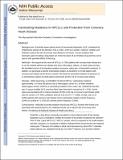| dc.contributor.author | Lander, Eric Steven | |
| dc.date.accessioned | 2015-06-03T16:16:27Z | |
| dc.date.available | 2015-06-03T16:16:27Z | |
| dc.date.issued | 2014-11 | |
| dc.identifier.issn | 0028-4793 | |
| dc.identifier.issn | 1533-4406 | |
| dc.identifier.uri | http://hdl.handle.net/1721.1/97178 | |
| dc.description.abstract | Background
Ezetimibe lowers plasma levels of low-density lipoprotein (LDL) cholesterol by inhibiting the activity of the Niemann–Pick C1-like 1 (NPC1L1) protein. However, whether such inhibition reduces the risk of coronary heart disease is not known. Human mutations that inactivate a gene encoding a drug target can mimic the action of an inhibitory drug and thus can be used to infer potential effects of that drug.
Methods
We sequenced the exons of NPC1L1
in 7364 patients with coronary heart disease and in 14,728 controls without such disease who were of European, African, or South Asian ancestry. We identified carriers of inactivating mutations (nonsense, splice-site, or frameshift mutations). In addition, we genotyped a specific inactivating mutation (p.Arg406X) in 22,590 patients with coronary heart disease and in 68,412 controls. We tested the association between the presence of an inactivating mutation and both plasma lipid levels and the risk of coronary heart disease.
Results
With sequencing, we identified 15 distinct NPC1L1 inactivating mutations; approximately 1 in every 650 persons was a heterozygous carrier for 1 of these mutations. Heterozygous carriers of NPC1L1 inactivating mutations had a mean LDL cholesterol level that was 12 mg per deciliter (0.31 mmol per liter) lower than that in noncarriers (P = 0.04). Carrier status was associated with a relative reduction of 53% in the risk of coronary heart disease (odds ratio for carriers, 0.47; 95% confidence interval, 0.25 to 0.87; P = 0.008). In total, only 11 of 29,954 patients with coronary heart disease had an inactivating mutation (carrier frequency, 0.04%) in contrast to 71 of 83,140 controls (carrier frequency, 0.09%).
Conclusions
Naturally occurring mutations that disrupt NPC1L1 function were found to be associated with reduced plasma LDL cholesterol levels and a reduced risk of coronary heart disease. | en_US |
| dc.description.sponsorship | National Human Genome Research Institute (U.S.) (Grant 5U54HG003067-11) | en_US |
| dc.language.iso | en_US | |
| dc.publisher | New England Journal of Medicine | en_US |
| dc.relation.isversionof | http://dx.doi.org/10.1056/NEJMoa1405386 | en_US |
| dc.rights | Creative Commons Attribution-Noncommercial-Share Alike | en_US |
| dc.rights.uri | http://creativecommons.org/licenses/by-nc-sa/4.0/ | en_US |
| dc.source | PMC | en_US |
| dc.title | Inactivating Mutations in NPC1L1 and Protection from Coronary Heart Disease | en_US |
| dc.type | Article | en_US |
| dc.identifier.citation | The Myocardial Infarction Genetics Consortium Investigators. “Inactivating Mutations in NPC1L1 and Protection from Coronary Heart Disease.” N Engl J Med 371, no. 22 (November 27, 2014): 2072–2082. | en_US |
| dc.contributor.department | Massachusetts Institute of Technology. Department of Biology | en_US |
| dc.contributor.mitauthor | Lander, Eric S. | en_US |
| dc.relation.journal | New England Journal of Medicine | en_US |
| dc.eprint.version | Author's final manuscript | en_US |
| dc.type.uri | http://purl.org/eprint/type/JournalArticle | en_US |
| eprint.status | http://purl.org/eprint/status/PeerReviewed | en_US |
| mit.license | OPEN_ACCESS_POLICY | en_US |
| mit.metadata.status | Complete | |
